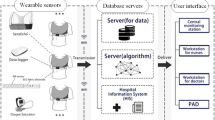Abstract
Objective. To determine if Robust Sensor Fusion (RSF), a method designedto fuse data from multiple sensors with redundant heart rate information canbe used to improve the quality of heart rate data. To determine if theimproved estimate of heart rate can reduce the number of false and missedheart rate alarms. Methods. A total of 85 monitoring periods wereinvestigated, 12 from the operating room, 60 from adult ICU and 13 frompediatric ICU. The operating room periods began with induction of anesthesiaand ended at the completion of the anesthetic. For the ICU data, four hourblocks of time were studied. For each monitoring period, HR values wererecorded at 5 second intervals or less from the ECG, SpO2 andIAC using a SpaceLabs Medical Gateway® connected to a SpaceLabs MedicalPC2®. Fused estimates of HR were derived for every time point using RSFand all results accepted regardless of confidence value. Data were annotatedmanually to identify the “reference” HR (that HR value mostlikely to be correct) at all time points. All HR values from the sensors andthe fused estimate that were different from the reference HR by more than±5 beats/min were considered inaccurate. For each monitoring period,the total time per hour that data were either inaccurate or unavailable wascalculated for each sensor as well as the fused estimates. The total time offalse and missed HR alarms was found for all sensors and the fused estimateby comparing the data to thresholds for both high and low HR alarms at 150bpm, 130 bpm, 110 bpm and 50 bpm, 40 bpm, 30 bpm respectively. Results. Thefused estimate of HR was consistently as good or better than the estimateavailable from any individual sensor. The fused estimates also consistentlyreduced the incidence of false alarms compared with individual sensorswithout an unacceptable incidence of missed alarms. Discussion. Redundancyin sensor measurements can be used to improve HR estimation in the clinicalsetting. Methods like RSF which improve the quality of monitored data andreduce nuisance alarms will enhance the value of patient monitors toclinicians.
Similar content being viewed by others
REFERENCES
Wesseling KH, Smith NT. Availability of intraarterial pressure waveforms from catheter-manometer systems during surgery. J Clin Monit 1985; 1: 11–16.
Feldman JM, Ebrahim M. Which sensor measures heart rate best? Anesthesiology 1995; 83(3A): A478.
Kestin IG, Miller BR, Lockhart CH. Auditory alarms during anesthesia monitoring. Anesthesiology 1988; 69: 106–109.
Ebrahim M, Feldman JM, Bar-Kana I. A robust sensor fusion method for heart rate estimation. J Clin Monit 1997; in press.
Author information
Authors and Affiliations
Rights and permissions
About this article
Cite this article
Feldman, J.M., Ebrahim, M.H. & Bar-Kana, I. Robust Sensor Fusion Improves Heart Rate Estimation: Clinical Evaluation. J Clin Monit Comput 13, 379–384 (1997). https://doi.org/10.1023/A:1007476707284
Issue Date:
DOI: https://doi.org/10.1023/A:1007476707284




